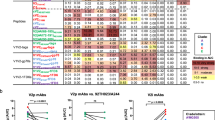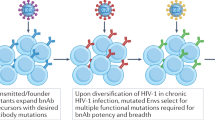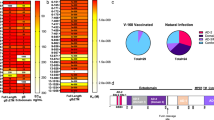Abstract
THE acquired immunodeficiency syndrome (AIDS) is the late-stage clinical manifestation of long-term persistent infection with the human immunodeficiency virus type 1 (HIV-1). Immune responses directed against the virus and against virus-infected cells during the persistent infection fail to mediate resolution of the infection. As a result, a successful AIDS vaccine must elicit an immune state that will prevent the establishment of the persistent infection following introduction of the virus into the host. The third hyper-variable (V3) domain of the HIV-1 gp120 envelope glycoprotein is a disulphide-linked closed loop of about 30 amino acids which binds and elicits anti-HIV-1 type-specific virus-neutralizing antibodies1–7. The in vitro characteristics of anti-V3 domain antibody suggest that this antibody could by itself prevent HIV-1 infection in vivo8,9, an idea supported by chimpanzee challenge studies in which protection against the HIV-1 persistent infection seemed to correlate with the presence of anti-V3 domain antibody10–12. Here we directly demonstrate the protective efficacy of anti-V3 domain antibody in vivo and propose that this antibody is potentially useful as both a pre- and post-exposure prophylactic agent.
This is a preview of subscription content, access via your institution
Access options
Subscribe to this journal
Receive 51 print issues and online access
$199.00 per year
only $3.90 per issue
Buy this article
- Purchase on Springer Link
- Instant access to full article PDF
Prices may be subject to local taxes which are calculated during checkout
Similar content being viewed by others
References
Leonard, C. K. et al J. biol. Chem. 265, 10373–10383 (1990).
Goudsmit, J. et al. AIDS 2, 157–164 (1988).
Goudsmit, J. et al. Proc. natn. Acad. Sci. U.S.A. 85, 4478–4482 (1988).
Ho, D. D. et al. J. Virol 61, 2024–2028 (1987).
Javaherlan, K. et al. Proc. natn. Acad. Sci. U.S.A. 86, 6768–6772 (1989).
Kenealy, W. R. et al. AIDS Res. Human Retroviruses 5, 173–182 (1989).
Rusche, J. R. et al. Proc. natn. Acad. Sci. U.S.A. 85, 3198–3202 (1988).
Linsley, P. S., Ledbetter, J. A., Kinney-Thomas, E. & Hu, S.-L. J. Virol. 62, 3695–3702 (1988).
Skinner, M. A. et al. J. Virol. 62, 4195–4200 (1988).
Berman, P. W. et al. Nature 345, 622–625 (1990).
Girard, M. et al. Proc. natn. Acad. Sci. U.S.A. 88, 542–546 (1991).
Emini, E. A. et al. J. Virol. 64, 3674–3678 (1990).
Matsushita, S. et al. J. Virol. 62, 2107–2114 (1988).
Robertson, G. A., Kostek, B. M., Schleif, W. A., Lewis, J. A. & Emini, E. A. J. virol. Meth. 20, 195–202 (1988).
Javaherian, K. et al. Science 250, 1590–1593 (1990).
Author information
Authors and Affiliations
Rights and permissions
About this article
Cite this article
Emini, E., Schleif, W., Nunberg, J. et al. Prevention of HIV-1 infection in chimpanzees by gpl20 V3 domain-specific monoclonal antibody. Nature 355, 728–730 (1992). https://doi.org/10.1038/355728a0
Received:
Accepted:
Issue Date:
DOI: https://doi.org/10.1038/355728a0
This article is cited by
-
Broadly neutralizing anti-HIV-1 monoclonal antibodies in the clinic
Nature Medicine (2019)
-
Antibody-mediated prevention and treatment of HIV-1 infection
Retrovirology (2018)
-
In vitro inhibition of HIV-1 replication in autologous CD4+ T cells indicates viral containment by multifactorial mechanisms
Virologica Sinica (2017)
-
Identifiable biomarker and treatment development using HIV-1 long term non-progressor sera
BMC Immunology (2015)
-
Moving ahead an HIV vaccine: To neutralize or not, a key HIV vaccine question
Nature Medicine (2011)
Comments
By submitting a comment you agree to abide by our Terms and Community Guidelines. If you find something abusive or that does not comply with our terms or guidelines please flag it as inappropriate.



